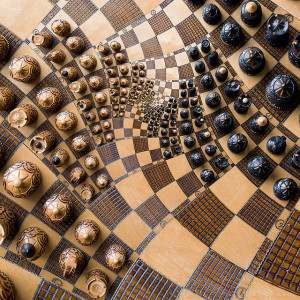Consider this fascinating vision of recursive chess — the etching below was created by Django Pinter, a tutorial student of mine who has just completed his degree in the PPL course here at Oxford, given to me as a parting gift at the conclusion of his studies. Django’s idea was to play chess, but in order for a capture to occur successfully on the board, as here with the black Queen attempting to capture the opposing white knight, the two pieces would themselves sit down for their own game of (recursive) chess. The idea was that the capture would be successful only in the event that the subgame was won. Notice in the image that not only is there a smaller recursive game of chess, but also a still tinier subrecursive game below that (if you inspect closely), while at the same time larger pieces loom in the background, indicating that the main board itself is already several levels deep in the recursion.

The recursive chess idea may seem clear enough initially, and intriguing. But with further reflection, we might wonder how does it work exactly? What precisely is the game of recursive chess? This is my question here.
My goal with this post is to open a discussion about what ultimately should be the precise the rules and operations of recursive chess. I’m not completely sure what the best rule set will be, although I do offer several proposals here. I welcome further proposals, commentary, suggestions, and criticism about how to proceed. Once we settle upon a best or most natural version of the game, then I shall hope perhaps to prove things about it. Will you help me decide what is the game of recursive chess?
Let me describe several natural proposals:
Naïve recursion. Although this seems initially to be a simple, sound proposal, ultimately I find it problematic. The naïve idea is that when one piece wants to capture another in the game at hand, then the two pieces themselves play a game of chess, starting from the usual chess starting position. I would find it natural that the attacking piece should play as white in this game, going first, and if that player wins the subgame, then the capture in the current game is successful. If the subgame is a loss, then the capture is unsuccessful.
There seem, however, to be a variety of ways to handle the losing subgame outcome, and since these will apply with several of the other proposals, let me record them here:
- Failed-capture. If the subgame is lost, then the capture in the current game simply does not occur. Both pieces remain on their original squares, and the turn of play passes to the opponent. Notice that this will have serious affects in certain chess situations involving zugzwang, a position where a player has no good move — because if one of them is a capture, then the player can aim to play badly in the subgame and thereby legally pass the turn of play to the opponent without having made any move. This situation will in effect cause the subgame players to attempt to lose, rather than win, which seems undesirable.
- Failed-capture-with-penalty. If the subgame is lost, then the capture does not occur, but furthermore, the attacking piece is itself lost, removed from the board, and the turn of play passes to the opponent. In effect, under this rule, every attempt at capture is putting the life of the capturing piece at risk, which makes a certain amount of sense from a military point of view. I think perhaps this is a good rule.
- Failed-capture-with-retry. If the subgame is lost, then the capture does not occur, but both pieces remain on their original squares, and the attacking player is allowed to proceed with another (different) move. Attempting the same attack from the same board position multiple times is subject to the three-fold repetition rule. This interpretation amounts in effect to the game play searching a large part of the game tree, exploring the possible capturing moves, but with the first successful option fixed as official. It invites manipulation by the opponent, who might play badly against a misguided capture attempt, causing it to be fixed as the official move.
- Drawn subgame. A further complication arises from the fact that the subgame can itself be drawn, rather than won. Is this sufficient to cause the penalty or the retry? Or does this count as a failed capture?
As I see it, however, the principal problem with the naïve recursion rule is that it seems to be ill-founded. After all, we can have a game with a capture, which leads to a subgame with a capture, which leads to a deeper subgame with a capture, and so on descending forever. How is the outcome determined in this infinitely descending situation? None of the subgames is ever resolved with a definite conclusion until all of them are, and there seems no coherent way to assign resolutions to them. All infinitely many subgames are simply left hanging mid-play, and indeed mid-move. For this reason, the naïve recursion idea seems ultimately incoherent to me as a game rule.
What we would seem to need instead is a well-founded recursion, one which would ultimately bottom-out in a base case. With such a recursion, every outcome of the game would be well-defined. Such a well-founded recursion would be achieved, for example, if on every subgame there were strictly fewer pieces. Eventually, the subgames would reduce to king versus king, a drawn game, and then the drawn subgame rule would be invoked to whatever affect it cause. But the recursion would definitely terminate. And perhaps most recursions would terminate because the stronger player was ultimately mating in all his attacks, without requiring any invocation of the drawn subgame rule.
We can easily describe several natural subgame positions with one fewer piece. For example, when one piece attacks another, we may naturally consider the positions that would result if we performed the capture, or if we removed the attacking piece; and we might further consider swapping the roles of the players in these positions. Such cases would constitute a well-founded recursion, because the subgame position would have fewer pieces than the main position. In this way, we arrive at several natural recursion rules for recursive chess.
Proof-of-sufficiency recursion. The motivating idea of this recursion rule is that in order for an attack to be successful, the attacking player must prove that it will be sufficient for the attack to be successful. So, when piece A attacks piece B in the game, then a subgame is set up from the position that would result if A were successfully to capture B, and the players proceed in the game in which the attack has occurred. This is the same as proceeding in the main game, under the assumption that the attack was successful. If the attacking player can win this subgame, then it shows in a sense the sufficiency of the attack as a means to win, and so on the proof-of-sufficiency idea, we allow this as a reason for the attack to have been successful.
One might object that this recursion seems at first to amount to just playing chess as usual, since the subgame is the same as the original game with the attack having succeeded. But there is a subtle difference. For a misguided attack, the attacked player can play suboptimally in the subgame, intentionally losing that game, and then play differently in the main game. There is, of course, no obligation that the players respond the same at the higher-level games as in the lower games, and this is all part of their strategic calculation.
Proof-of-necessity recursion. The motivating idea of this recursion rule, in contrast, is that in order for an attack to be successful, the attacking player must prove that it is necessary that the attack take place. When piece A attacks piece B in the main game, then a subgame is set up in which the attack has not succeeded, but instead the attacking piece is lost, but the color sides of the players are swapped. If a black Queen attacks a white knight, for example, then in the subgame position, the queen is removed, and the players proceed from that positions, but with the opposite colors. By winning this subgame, the attacking player is in effect demonstrating that if the attack were to fail, then it would be devastating for them. In other words, they are demonstrating the necessity of the success of the attack.
For the both the proof-of-sufficiency and the proof-of-necessity versions of the recursion, it seems to me that any of the three failed-capture rules would be sensible. And so we have quite a few different interpretations here for what is the game of recursive chess.
What is your proposal? Please let me know in the comments. I am interested to hear any comments or criticism.




 Shall we have a game of transfinite Nim? One of us sets up finitely many piles of wooden blocks, each pile having some ordinal height, possibly transfinite, and the other of us decides who shall make the first move. Taking turns, we each successively remove a top part of any one pile of our choosing, making it strictly shorter. Whoever takes the very last block wins. (It is fine to remove an entire pile on a turn or to remove blocks from a different pile on a later turn.)
Shall we have a game of transfinite Nim? One of us sets up finitely many piles of wooden blocks, each pile having some ordinal height, possibly transfinite, and the other of us decides who shall make the first move. Taking turns, we each successively remove a top part of any one pile of our choosing, making it strictly shorter. Whoever takes the very last block wins. (It is fine to remove an entire pile on a turn or to remove blocks from a different pile on a later turn.)


